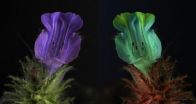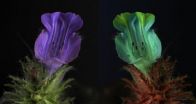INFORMATION:
Image credits: Jolyon Troscianko
Two Tenerife lizards (Gallotia galloti) basking. The image on the left is in human-visible colours and although the male at the top is more colourful than the female at the bottom, he is still fairly well camouflaged amongst the foliage. However, the dusky blue/grey patches on his cheek and bars on his flank are much more conspicuous to the female lizard than ourselves, as highlighted in the false colour UV image on the right. This demonstrates how colours can be used as private signals in some species where evolutionary pressures for sexual signalling compete with evading predators.
Dandelion as seen to human vision (left), and honeybee vision (right). The centre of the flower absorbs UV while the ends of the petals reflects it.
Echium angustifolium in Tenerife (Borage family). To us the flowers are a fairly uniform purple, but bees can see two UV absorbent patches at the top of the flower.
Lesser Celandine in human-vision (left) and honeybee vision (right). There's a striking colour difference in UV. The whole flower looks yellow to us, however the petals reflect UV strongly and absorb blue (so look purple in this image), while the pollen in the centre doesn't reflect UV, so looks red. This makes the flower look much more colourful to bees than ourselves.
Contact
University of Exeter Press Office
pressoffice@exeter.ac.uk
+44(0)1392 722 062 / +44(0)7827 309 332
Twitter: @UoE_ScienceNews
For urgent enquiries outside normal office hours please ring +44(0)7867 536 750 or email pressoffice@exeter.ac.uk
About the University of Exeter
The University of Exeter is a Russell Group university and in the top one percent of institutions globally. It combines world-class research with very high levels of student satisfaction. Exeter has over 19,000 students and is ranked 7th in The Times and The Sunday Times Good University Guide league table, 10th in The Complete University Guide and 9th in the Guardian University Guide 2015. In the 2014 Research Excellence Framework (REF), the University ranked 16th nationally, with 98% of its research rated as being of international quality. Exeter was The Sunday Times University of the Year 2012-13.
The University has four campuses. The Streatham and St Luke's campuses are in Exeter and there are two campuses in Cornwall, Penryn and Truro. The 2014-2015 academic year marks the 10-year anniversary of the two Cornwall campuses. In a pioneering arrangement in the UK, the Penryn Campus is jointly owned and managed with Falmouth University. At the campus, University of Exeter students can study programmes in the following areas: Animal Behaviour, Conservation Biology and Ecology, English, Environmental Science, Evolutionary Biology, Geography, Geology, History, Human Sciences, Marine Biology, Mining and Minerals Engineering, Politics and International Relations, Renewable Energy and Zoology.
The University has invested strategically to deliver more than £350 million worth of new facilities across its campuses in the past few years; including landmark new student services centres - the Forum in Exeter and The Exchange at Penryn - together with world-class new facilities for Biosciences, the Business School and the Environment and Sustainability Institute. There are plans for another £330 million of investment between now and 2016.
http://www.exeter.ac.uk/cornwall
About the University of Exeter's Centre for Ecology and Conservation (CEC)
Staff at the Centre for Ecology and Conservation, based on the Penryn Campus, undertake cutting-edge research that focusses on whole organism biology. The CEC has three interlinked research groups: Behaviour, Ecology and Conservation, and Evolution which constitute 40 academics and over 100 early career researchers. It engages widely with businesses, charities and government agencies and organisations in Cornwall, the Isles of Scilly and beyond to translate its research into societal impact. Staff at the CEC deliver educational programs to some 500 undergraduate and 100 postgraduate students.
A new £5.5 million Science and Engineering Research Support Facility (SERSF) is currently under construction at the Penryn Campus. The facility will bring pioneering business, science and engineering together and will provide space for the growing CEC alongside the University of Exeter Business School, which is expanding into Cornwall, and the University's Marine Renewables team.
The University of Exeter and Falmouth University are founding partners in the Combined Universities in Cornwall (CUC), a unique collaboration between six universities and colleges to promote regional economic regeneration through Higher Education, funded mainly by the European Union (Objective One and Convergence), the South West Regional Development Agency and the Higher Education Funding Council for England, with support from Cornwall Council.
http://biosciences.exeter.ac.uk/cec/
Animal-eye view of the world revealed with new visual software
New camera technology that reveals the world through the eyes of animals has been developed by University of Exeter researchers
2015-08-06
(Press-News.org) New camera technology that reveals the world through the eyes of animals has been developed by University of Exeter researchers. The details are published today in the journal Methods in Ecology and Evolution.
The software, which converts digital photos to animal vision, can be used to analyse colours and patterns and is particularly useful for the study of animal and plant signalling, camouflage and animal predation, but could also prove useful for anyone wanting to measure colours accurately and objectively.
The software has already been used by the Sensory Ecology group in a wide range of studies, such as colour change in green shore crabs, tracking human female face colour changes through the ovulation cycle, and determining the aspects of camouflage that protect nightjar clutches from being spotted by potential predators.
Jolyon Troscianko from the Centre for Ecology and Conservation at the University of Exeter said: "Viewing the world through the eyes of another animal has now become much easier thanks to our new software.
"Digital cameras are powerful tools for measuring colours and patterns in nature but until now it has been surprisingly difficult to use digital photos to make accurate and reliable measurements of colour. Our software allows us to calibrate images and convert them to animal vision, so that we can measure how the scene might look to humans and non-humans alike.
"We hope that other scientists will use this open access software to help with their digital image analysis."
Until now, there has been no user-friendly software programme that enables researchers to calibrate their images, incorporate multiple layers - visible and UV channels -, convert to animal colour spaces, and to measure images easily. Instead, researchers have needed to do much of this manually, including the sometimes complex programming and calculations involved. This freely available open source software now offers a user-friendly solution.
Colour vision varies substantially across the animal kingdom, and can even vary within a given species. Most humans and old-world monkeys have eyes sensitive to three colours; red, green and blue, which is more than other mammals that are only sensitive to blue and yellow. It is impossible for humans to imagine seeing the world in more than three primary colours, but this is common in most birds, reptiles, amphibians and many insects that see in four or more. Many of them can also see into the ultraviolet range, a world completely invisible to us without the use of full spectrum cameras. So scientists studying these species need to measure UV to understand how these animals view the world.
Using a camera converted to full spectrum sensitivity, one photograph taken through a visible-pass filter can be combined by the software with a second taken through an ultraviolet-pass filter. The software can then generate functions to show the image through an animal's eyes.
The researchers have provided specific data on camera settings for commonly studied animals, such as humans, blue tits, peafowl, honey bees, ferrets and some fish.
Flowers often look particularly striking in UV because they are signalling to attract pollinators that can see in UV, such as bees. UV is also often important for birds, reptiles and insects in their colourful sexual displays to attract mates.
The software is free to download and is available here.
Image Calibration and Analysis Toolbox - a free software suite for measuring reflectance, colour, and pattern objectively and to animal vision by Jolyon Troscianko & Martin Stevens is published in Methods in Ecology & Evolution.
ELSE PRESS RELEASES FROM THIS DATE:
Dasabuvir and ombitasvir/paritaprevir/ritonavir: Hint of added benefit in further patients
2015-08-06
Dasabuvir (trade name Exviera) and the fixed-dose drug combination ombitasvir/paritaprevir/ritonavir (trade name Viekirax) have been available since January 2015 for the treatment of adults with chronic hepatitis C infection. The German Institute for Quality and Efficiency in Health Care (IQWiG) had examined their added benefit in a dossier assessment completed in April 2015.
In an addendum, the Institute now assessed study data subsequently submitted by the drug manufacturer in the commenting procedure. According to the findings, the results of an indirect comparison ...
Saturn's rings in a supercomputer
2015-08-06
Why some planets, like Saturn or Jupiter, have their rings, while others like, the Earth or Mars do not? It turned out that "the size does not matter" -- not only giants as Saturn possess the rings, but even tiny asteroids do: According to the recent discovery of the Spitzer Space Telescope, the remote asteroid Chariklo, which is only 260 km in diameter, also has rings.
A natural answer may be the following: Occasionally, in a far past, some planets had much more material in their vicinity then the other ones. The material was in a form of dust. Dust particles merged ...
Long-term ovarian cancer survival higher than thought
2015-08-06
UC Davis study should help guide patients and their oncologists
(SACRAMENTO, Calif.) -- Combing data collected on thousands of California ovarian cancer patients, UC Davis researchers have determined that almost one-third survived at least 10 years after diagnosis.
The unprecedented findings upend the notion that women diagnosed with cancer of the ovary always face a poor chance of survival. In fact, while the study confirmed earlier findings on characteristics associated with ovarian cancer survival -- younger age, earlier stage and lower grade tumors at diagnosis ...
Making a better nitrate test kit
2015-08-06
The dull black plastic of the device on Joshua Pearce's desk belies its usefulness. Pearce picks up the box, which has a switch on the side and a small opening on top. A handful of vials sit in a bag nearby, and each would fit snugly in the opening. The set-up seems generic, even bland, except that it could radically change how we deal with water quality issues.
Pearce, who has a joint appointment as an associate professor of materials science and engineering as well as electrical and computer engineering, runs an open sustainability technology lab at Michigan Technological ...
Population changes, priorities cause woodlands to increase
2015-08-06
COLLEGE STATION - Woody plant encroachment is one of the biggest challenges facing rangelands worldwide, but it consistently has been under-measured and poorly understood, said a Texas A&M AgriLife Research scientist in College Station.
Dr. Matthew Berg, an AgriLife Research postdoctoral research associate in the Texas A&M department of ecosystem and science management, is trying to change both the understanding and measurement with his latest study, which was captured in the July issue of the Rangeland Ecology and Management publication, http://bit.ly/1JK8JhU.
Berg ...
Power grid forecasting tool reduces costly errors
2015-08-06
Accurately forecasting future electricity needs is tricky, with sudden weather changes and other variables impacting projections minute by minute. Errors can have grave repercussions, from blackouts to high market costs. Now, a new forecasting tool that delivers up to a 50-percent increase in accuracy and the potential to save millions in wasted energy costs has been developed by researchers at the Department of Energy's Pacific Northwest National Laboratory.
Performance of the tool, called the Power Model Integrator, was tested against five commonly used forecasting ...
Siblings of children with schizophrenia show resilience to the condition as they grow up
2015-08-06
Fundamental differences between how the brain forms during adolescence have been discovered in children with schizophrenia and their siblings, a new study shows.
The study opens up new avenues for researchers to explore when developing treatment for the illness, which can be hugely debilitating for children.
Researchers from the University of Melbourne and the National Institute of Mental Health in Washington DC used structural brain magnetic resonance imaging (MRI) to map the brains of 109 children with childhood-onset schizophrenia (COS), from ages 12 to 24.
They ...
Diabetes drug modulates cholesterol levels
2015-08-06
The DZD-researchers at Helmholtz Zentrum München and German Diabetes Center Düsseldorf analyzed more than 1.800 blood samples of participants, who joined the German large-scale study KORA*. Using a comprehensive approach, the scientists investigated metabolic products (metabolites) as well as genetics of these participants. They found that the administration of Metformin** in patients suffering from Type 2 Diabetes led to a change in metabolite levels. According to the authors, this was associated with a significantly decreased level of LDL cholesterol***, which ...
DNA repair: Pincer attack
2015-08-06
First the scaffold is cracked, then defective parts are removed: Cells repair damaged DNA by a different mechanism than so far assumed, as chemists from Ludwig-Maximilians-Universitaet (LMU) in Munich have shown.
Defects in DNA can cause serious harm to an organism, including cell death or the development of cancer. Efficient repair mechanisms are therefore of vital importance. LMU chemist Professor Christian Ochsenfeld, Chair of Theoretical Chemistry at LMU, and Dr. Keyarash Sadeghian from his group have explained for the first time in detail how a human DNA repair ...
Even if severe allergic reaction is in doubt, epinephrine should be used
2015-08-06
ARLINGTON HEIGHTS, Ill. (August 6, 2015) - There are times when emergency physicians can't be 100 percent sure a person is suffering from a severe allergic reaction, known as anaphylaxis, and may hesitate to use epinephrine. A new article says when in doubt - administer the epinephrine.
An article in the Annals of Allergy, Asthma and Immunology, the scientific publication of the American College of Allergy, Asthma and Immunology (ACAAI), highlights recommendations from a panel discussion among allergists and emergency physicians. The panel of experts examined barriers ...
LAST 30 PRESS RELEASES:
Numbers in our sights affect how we perceive space
SIMJ announces global collaborative book project in commemoration of its 75th anniversary
Air pollution exposure and birth weight
Obstructive sleep apnea risk and mental health conditions among older adults
How talking slows eye movements behind the wheel
The Ceramic Society of Japan’s Oxoate Ceramics Research Association launches new international book project
Heart-brain connection: international study reveals the role of the vagus nerve in keeping the heart young
Researchers identify Rb1 as a predictive biomarker for a new therapeutic strategy in some breast cancers
Survey reveals ethical gaps slowing AI adoption in pediatric surgery
Stimulant ADHD medications work differently than thought
AI overestimates how smart people are, according to HSE economists
HSE researchers create genome-wide map of quadruplexes
Scientists boost cell "powerhouses" to burn more calories
Automatic label checking: The missing step in making reliable medical AI
Low daily alcohol intake linked to 50% heightened mouth cancer risk in India
American Meteorological Society announces Rick Spinrad as 2026 President-Elect
Biomass-based carbon capture spotlighted in newly released global climate webinar recording
Illuminating invisible nano pollutants: advanced bioimaging tracks the full journey of emerging nanoscale contaminants in living systems
How does age affect recovery from spinal cord injury?
Novel AI tool offers prognosis for patients with head and neck cancer
Fathers’ microplastic exposure tied to their children’s metabolic problems
Research validates laboratory model for studying high-grade serous ovarian cancer
SIR 2026 delivers transformative breakthroughs in minimally invasive medicine to improve patient care
Stem Cell Reports most downloaded papers of 2025 highlight the breadth and impact of stem cell research
Oxford-led study estimates NHS spends around 3% of its primary and secondary care budget on the health impacts of heat and cold in England
A researcher’s long quest leads to a smart composite breakthrough
Urban wild bees act as “microbial sensors” of city health.
New study finds where you live affects recovery after a hip fracture
Forecasting the impact of fully automated vehicle adoption on US road traffic injuries
Alcohol-related hospitalizations from 2016 to 2022
[Press-News.org] Animal-eye view of the world revealed with new visual softwareNew camera technology that reveals the world through the eyes of animals has been developed by University of Exeter researchers





